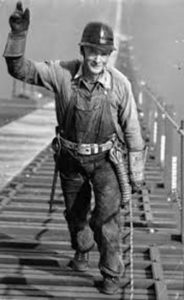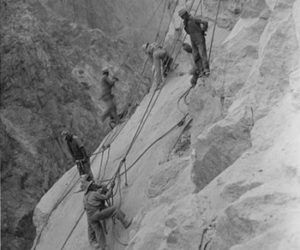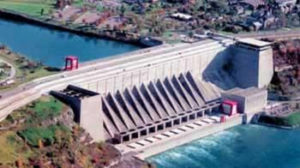Historical context:
 Consider the Golden Gate Suspension Bridge (San Francisco) built between 1933 and 1937, an architectural marvel, thought to be impossible because in order to bridge that 6,700 ft. strait, in the middle of the bay channel, against strong tides, fierce winds, and thick fog, meant overcoming almost impossible odds. But it was built, with a grand opening in May of 1937, deemed, at the time of its completion, to be the tallest suspension bridge in the world as well as the longest. A man named Joseph Strauss engineered many new ideas, including developing safety devices such as movable netting, which saved 19 lives; though in all, there were 11 men lost during this construction. Thousands of men – workers of varying ages and from varied ethnic groups – came together to complete this project. (They had to listen and learn to be successful together.)
Consider the Golden Gate Suspension Bridge (San Francisco) built between 1933 and 1937, an architectural marvel, thought to be impossible because in order to bridge that 6,700 ft. strait, in the middle of the bay channel, against strong tides, fierce winds, and thick fog, meant overcoming almost impossible odds. But it was built, with a grand opening in May of 1937, deemed, at the time of its completion, to be the tallest suspension bridge in the world as well as the longest. A man named Joseph Strauss engineered many new ideas, including developing safety devices such as movable netting, which saved 19 lives; though in all, there were 11 men lost during this construction. Thousands of men – workers of varying ages and from varied ethnic groups – came together to complete this project. (They had to listen and learn to be successful together.)
 Consider the feat of building the monumental Hoover Dam (1931-1936) – a miracle of technology and engineering. No dam project of this scale had ever been attempted before. There were 21,000 people working at that site with approximately 100 industrial deaths. The walls for this structure – that would uphold the weight of the dam – required workers called “high-scalers” who excavated the cliffs, dangling on ropes from the rim of the canyon. Can you even fathom this?
Consider the feat of building the monumental Hoover Dam (1931-1936) – a miracle of technology and engineering. No dam project of this scale had ever been attempted before. There were 21,000 people working at that site with approximately 100 industrial deaths. The walls for this structure – that would uphold the weight of the dam – required workers called “high-scalers” who excavated the cliffs, dangling on ropes from the rim of the canyon. Can you even fathom this?
 Consider the great Niagara Power Project (1957-1961). During construction, over 12 million cubic yards of rock were excavated. A total of 20 workers died. When it opened in 1961, it was the Western world’s largest hydropower facility. Many people, including from the “greatest generation” and the “traditionalist generation,” worked together on this project. It was a 24/7, multi-year project.
Consider the great Niagara Power Project (1957-1961). During construction, over 12 million cubic yards of rock were excavated. A total of 20 workers died. When it opened in 1961, it was the Western world’s largest hydropower facility. Many people, including from the “greatest generation” and the “traditionalist generation,” worked together on this project. It was a 24/7, multi-year project.
Note that the Niagara Power Project, the Golden Gate Bridge and the Hoover Dam construction (detailed above) all occurred before OSHA was in existence – the protections were sparse so people (young and old) had to especially look out for each other! Each of these great projects, nonetheless, took lives – workers that did not come home to their loved ones.
Today’s multigenerational Workplace – with Greater Safety Emphasis and Engagement
Fast forward to today…to your workplace…a different time and place…where people of multi-generations also come together for a purpose – to complete the work of your respective business (safely). Managing multi-generational workforces is an art in itself.
- Young workers want to contribute and make a quick impact, valuing inclusion
- The middle generation needs to believe in the mission – it has to make sense – they have to see the “why” of it
- The older employees don’t like ambivalence; they’re looking for clarity, straight-forwardness, and no wishy-washy explanations
Does that make success (together) impossible? Absolutely not. The common denominator is that all people, regardless of their labeled generation, want to be accepted for who they are, to have their contribution valued, and to feel a part of the team/business endeavor. All want to go home from work safe. The need for their brother’s/sister’s keeper remains paramount.
In today’s workplaces, we often have a co-worker population that can represent age ranges of forty-plus years. With that range comes a host of different experiences, expectations and perspectives, and technology prowess. (All good; all offer ways to learn from each other.)
Everyone in the workplace came to there because of the employment opportunity – the opportunity to make a living – in order to provide for themselves and their families. (That’s a collective no-brainer…and the place to start in safety-mindedness – so we can all keep earning a living with all our parts, hands, toes, eyes, ears, etc. all in-tact, every day, regardless of what generation we touch.)
Granted, there are some differences in how teamwork is viewed, loyalty to the job and dealing with change, work-life balance, diversity, rewards and recognition, decision-making, personal growth and development – yet all of these differences are surmountable. Consider too, that all of these differences pale in comparison to the generations that went before, who demonstrated that when working together, toward a clear purpose, were able to complete the type of monumental projects described earlier in this article. To do what they did, required extraordinary teamwork.
I’m reminded of the (illustrative) story of four people going gulf fishing in a boat – a Traditionalist, a Boomer, an X-er, and a Millennial. All of a sudden the boat’s captain fell over dead with a heart attack and, in that process, did something destructive to the boat’s motor key mechanism as he fell over, as well as hitting the radio – breaking its channel mechanism. The boat stalled – dead in the water. Fully adrift.
So the combination of four people had to figure out how they’d get back to shore. Each of them devised a workable plan and got to work. The Traditionalist quickly determined what he could salvage from the boat to make more workable oars for paddling back to the shoreline and readied safety flares for expected overhead helicopters or airplanes; he also knew, instinctively, their directional status, fully understanding the sun’s position in the sky.
The Boomer hunted for and found the boat’s engine manual and was troubleshooting the starting mechanism, and how to bypass it – to restart the engine – plus was troubleshooting the boat’s radio, etc.
The X-er immediately used his phone’s GPS coordinates and was preparing to call in to the Coast Guard for help. The Millennial quickly text messaged an SOS to the Coast Guard with emphasis for HELP!
We often resort to solving problems with the technology to which we are most accustomed. In this illustration, each method had value. Each had potential to solve the problem and return the group to shore! Each person, regardless of his/her generational label, has something important to offer – a way of thinking about things. We each have ideas to offer for solving problems in our workplace; we are each other’s brother/sister in the workplace. We are all in the same boat!
We all can learn from each other, especially in safety. We all can listen to each other. History teaches good lessons. We all can share our concerns, our expectations, our perspectives, our technologies…for the betterment of the success of whatever it is that we came together to do (together).
We, at R.N. Knowles & Associates, work with leaders, teams, organizations, and businesses, helping them to solve their complex problems (together). We know that complex situations require new ways of thinking and being. We also are keen on the use of the Process Enneagram© because it is the proven “tool of complexity” that helps leaders and their teams resolve their complex issues (together and quickly). It allows for extensive input, ideas, perspectives, realities, understanding, and acceptance of various ideas, sharing and learning…so that we bridge perception differences and viewpoint gaps around any complex issue that you are facing. When we learn from our individual talents and work as a team, there is no limit to our potential achievements – including our collective safety!
Call us at 716-622-6467and we’ll show you how it can work for your organization, too.






Speak Your Mind